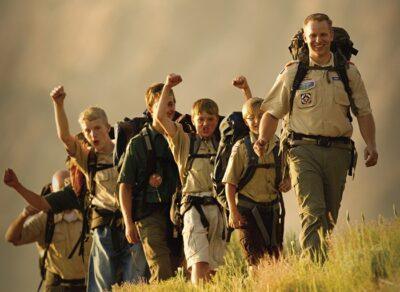Survival is not a joke — or a TV show. More often than not, what we need in a survival situation is a level head, clear thinking, and a few well-practiced survival skills to keep us alive until help arrives.
And, above all, we should have the right attitude for survival. In this regard, the Boy Scouts can teach us a few basics:
1. The Survival Attitude
Survival is a basic animal instinct, no doubt, but for modern-day humans alienated from nature, it should be more of an attitude. We have become so dependent on the state machinery to protect us and provide for our needs that we rarely spare a thought on survival and self-preservation as our personal goal. The Boys Scouts introduce children to out-of-the-ordinary situations that trigger their latent survival instinct, and also teach them the ways and means of doing it.
Their survival instinct is nurtured by the following:
- Learning essential skills
- Readiness for hard work
- Ability to withstand hardships
- Facing challenges with confidence and courage
- Troubleshooting
- Planning and action
- Team dynamics
2. STOP — And Proceed
The Boys Scouts advise the STOP strategy in survival situations. Panic and wandering about without a fixed plan can undermine your survival.
The Secret To Starting Fires In Even The Most Extreme Conditions
STOP stands for:
S — Stop
T — Think
O — Observe
P — Plan
Stopping in your tracks to take stock of the situation may help you get your bearings. Think about the different options you have, whether it is best to wait for help or actively look for it. Keen observation of the surroundings will help you assess your prospects in finding your way back or settling down as best as you can. Having a definite plan can give you confidence and a sense of purpose as you methodically work for survival.
3. To Be Prepared
The Scout motto of “be prepared” has very real practical use when it comes to survival. We may think that it is impossible to be prepared for disasters, as they seem to strike unexpectedly. But that’s not always true. Disasters seem unexpected because we often fail to stretch our imagination to the possibilities. Preparedness takes into consideration both the possibility of different types of dangers, as well as the tools and skills needed to face them.
- Being aware of possible dangers. The places we live in, be it seaside, plains, highlands or areas near deserts or woods, come with their share of possible natural disasters. Tsunamis, tornados, hurricanes and bush fires can strike us even if we stay put. Add to that the real possibility of getting lost on a camping trip or a hike, or having to escape to wilder areas in a man-made emergency that is all too imaginable in today’s terror-ridden world.
- Having the basic tools of survival handy. The Boys Scouts recommend different types of survival kits for different occasions, since the requirements vary depending on where you are. For example, what you need on a sailing trip is far different from the essentials you should have in the wilderness. So you should be packing in your wilderness survival kits for camping out, seafaring kits for sailing, but there’s also the personal survival kit that is meant to be carried on the person at all times.
The basic tools of survival fall primarily into four categories:
- Signaling for help. According to statistics, people who wait for rescuers have a higher chance of survival than those who wander about looking for help. The moment you realize you’re lost, the priority should be calling for help, especially if you’re part of a group that would be looking for you. Boy Scouts would have practice making use of whistles, flashlights, signaling mirrors, working together as a group and individually. If you’re alone on your trail, or stranded in some place you’re not expected to be, as in a ship wreck or plane crash, then flares or smoke signals that can be seen from above may make more sense.
- Making a shelter. Camping trips that Boy Scouts participate in teach them the basics of making shelters to protect them from the elements. In cold climates, hypothermia is a more immediate and significantly greater risk than lack of food and water. Children are exhorted to come prepared with sleeping bags or plastic sheets that can be fashioned into a shelter. Advanced survival camps will teach them how and where to build shelters with materials found in the area to get maximum protection. Through experience they also learn how smaller shelters and sharing the space with buddies can preserve warmth better.
- Making a fire. Being able to make fire can increase your chances of survival manifold. That’s why Boy Scouts need to demonstrate three different ways to make fire without matches to earn their wilderness survival badge. While matches and lighters are handy devices and must-haves in every survival tool kit, spark-maker tools like magnesium sticks and steel knife, along with tinder and char cloth, should be included as well.
- Learning first aid and medication for injuries. Disinfectants, antibiotic ointments, clean bandages, anti-allergic medications, etc., should be included in the kit. These, along with correct, practical knowledge of emergency maneuvers often taught to the Boy Scouts, can be lifesaving.
But there are other preparedness skills the Scouts learn, such as:
Protection from predators. Fire is a deterrent to many wild animals and pesky pests. But you will need to arm yourself with a potent weapon, such as a sharp knife, heavy rod or rock when faced with potentially dangerous animals or humans. Boys Scouts teach that offense is not always the best defense. Camouflage, quietly backing out, or in some cases, making a ruckus to scare away a predator might work better.
Ultra-Efficient Water Filter Fits In Your Pocket!
Finding food and water. Dehydration can be a killer, so finding water and making it safe to drink with water purification tablets or condensation techniques is important. Food is the last priority, and as Scouts are taught, eating wild berries or bugs can cause more harm than good in most situations. That’s why they are taught fishing and hunting skills.
Getting equipped with the skills to use the tools. Nowadays, you don’t have to search for each and every item in your survival kit; compactly packed survival tool sets are available off the shelf. But having a kit in hand is only as good as your skills in using them. An emergency is not the time to learn by trial and error. That’s where the Boy Scouts have an advantage due to their hands-on learning. The Boy Scouts Fieldbook is a great resource on everything related to survival in various situations.
4. Practice makes perfect
Bookish knowledge or TV episodes will not help you unless you complement it with hands-on experience. That’s one thing that Boys Scouts value above everything — and we should, too. There are several survival skills we can practice at home and in the backyard, such as:
- Basic first-aid
- Reading maps
- Finding directions by day and night
- Making fire with a variety of materials
- Extracting drinking water from a patch of grass or a bough
- Using signaling mirrors
- Making quick shelters
Camping trips to different places can be excellent occasions to try out the many skills learned at home. They will help us become aware of the real challenges one might have to face out there in the wild and be better prepared in future. It may also help us remain “physically strong and mentally awake,” as the Boy Scouts oath requires.
What are other survival skills we can learn from the Scouts? Share your suggestions in the section below:
 Off The Grid News Better Ideas For Off The Grid Living
Off The Grid News Better Ideas For Off The Grid Living






